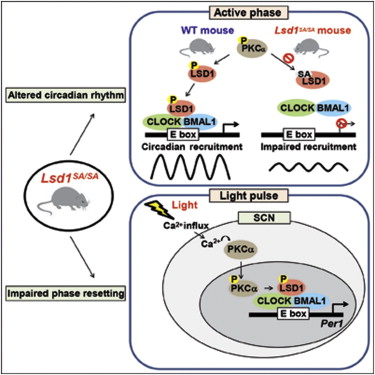博文
这是个黑童话么?——MC封面文章
|

On the cover: LSD1 phosphorylation plays a critical role in circadian rhythmicity and phase resetting in vivo. In this issue, Nam et al. (pp. 791–805) demonstrate a new mechanism of circadian signal-modulated LSD1 at an organism level. LSD1 is phosphorylated by PKCa either in a circadian rhythm-dependent manner or by photic stimuli. This phosphorylated LSD1 in turn facilitates E box-mediated transcriptional activation (depicted by the WT mouse running into the lighting “phosphorylation” gate). Knockin mice bearing a phosphorylation-defective LSD1SA/SA allele are represented by the mouse with the broken clock and sunglasses. This mutant mouse is unable to sense light and parading in the middle, unaware of the threat (the cat) near him, symbolizing altered circadian rhythms.

The circadian clock is a self-sustaining oscillator that controls daily rhythms. For the proper circadian gene expression, dynamic changes in chromatin structure are important. Although chromatin modifiers have been shown to play a role in circadian gene expression, the in vivo role of circadian signal-modulated chromatin modifiers at an organism level remains to be elucidated. Here, we provide evidence that the lysine-specific demethylase 1 (LSD1) is phosphorylated by protein kinase Cα (PKCα) in a circadian manner and the phosphorylated LSD1 forms a complex with CLOCK:BMAL1 to facilitate E-box-mediated transcriptional activation. Knockin mice bearing phosphorylation-defective Lsd1SA/SA alleles exhibited altered circadian rhythms in locomotor behavior with attenuation of rhythmic expression of core clock genes and impaired phase resetting of circadian clock. These data demonstrate that LSD1 is a key component of the molecular circadian oscillator, which plays a pivotal role in rhythmicity and phase resetting of the circadian clock.
https://blog.sciencenet.cn/blog-982855-775325.html
上一篇:你是猴子请来的啥?
下一篇:巴德年院士科大报告语摘——受益匪浅